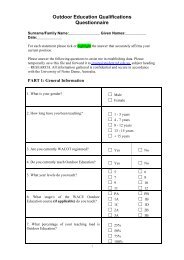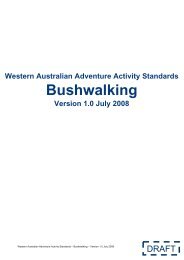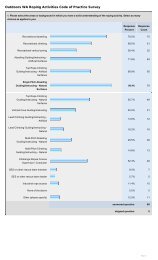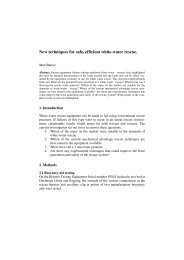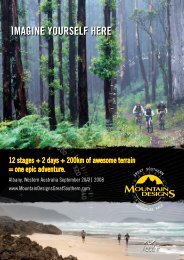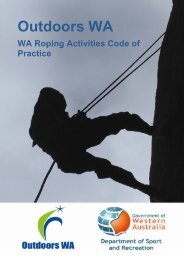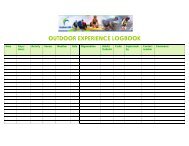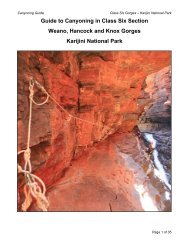Outdoor Adventure Activities Benefits Catalogue - Outdoors WA
Outdoor Adventure Activities Benefits Catalogue - Outdoors WA
Outdoor Adventure Activities Benefits Catalogue - Outdoors WA
You also want an ePaper? Increase the reach of your titles
YUMPU automatically turns print PDFs into web optimized ePapers that Google loves.
exercise effectively raises the levels of physical activity, reduces blood pressure and improvesthe quality of life of the patient.Pryor, Carpenter and Townsend (2005) outline the mechanisms by which outdoor adventureactivities constitute health promotion interventions. <strong>Outdoor</strong> adventure activities are shown toassist individuals towards “improved physical, mental, social, community and environmentalhealth and well-being” (p.4).Doney and Packer (2008) evaluated the psychometric properties of the Australian version ofthe Activity Card Sort (ACS-Aus) designed to measure the activity participation of olderadults. Participants in the study were older adults (aged 60-95, n=93) and results validated theeffectiveness of the method of measurement. The study reinforced the World HealthOrganisation’s promotion of participation in physical activity for the healthy ageing process.Vaughan et al (Vaughan, Kilkkinen, Philpot, Brooks, Schoo, Laatikainen, Chapman, Janus, &Dunbar, 2008) assessed the physical activity (PA) behaviours of adults living in rural areas inthe south-east of South Australia. In a randomly selected group of adults (n=1546), one-fifthwere found to lead an inactive lifestyle. Rural areas were noted as having higher levels ofchronic disease related to physical inactivity than other parts of Australia. Leisure-time PAwas seen as having the greatest potential for improvements at a population level.TherapeuticThe therapeutic benefits of outdoor adventure activities are found in the bush adventuretherapy literature. Most findings highlight benefits at an individual level and relate topsychological and psychosocial domains. Therapeutic programs utilise a range of outdooradventure activities to achieve their goals, and commonly include rural or remote areaenvironments, challenge ropes courses, initiate tasks, bushwalking and expeditions, canoeing,and abseiling in the programs.The benefits of bush therapy programs outlined in the following research are related generallyto vulnerable populations such as at-risk youth and the mentally ill. The studies show greaterbenefits for individuals involved in longer outdoor programs, programs that integrate solo andreflective opportunities, and programs involving wilderness-based journeys (as opposed toresidential and shorter term experiences).Brand’s PhD thesis (2000) was a longitudinal study of the effects of a Wilderness EnhancedProgram (WEP) on behaviour disordered adolescents. The study had pre and post tests on acontrol (n=37), experimental (n=34) and reference group (n=43) with the Jessor and Jessor’sProblem Behaviour Proneness Model as a guide for the self-report questionnaire. Thirty-onescales were developed that tested variables deemed to be good predictors of problembehaviour proneness. The subjects were tested five times over a two-year period. The studyconcluded that a WEP of two years duration did appear to cause significant changes inproblem behaviour.Martin and Legg (2002) conducted a mixed methods study comparing the personaldevelopment of adult participants on Outward Bound New Zealand courses of differentdurations (22 days n=54 and 9 days n=39). Findings from the data show the benefits ofparticipation in the journey-based programs to be enhanced personal and interpersonalPage 16






